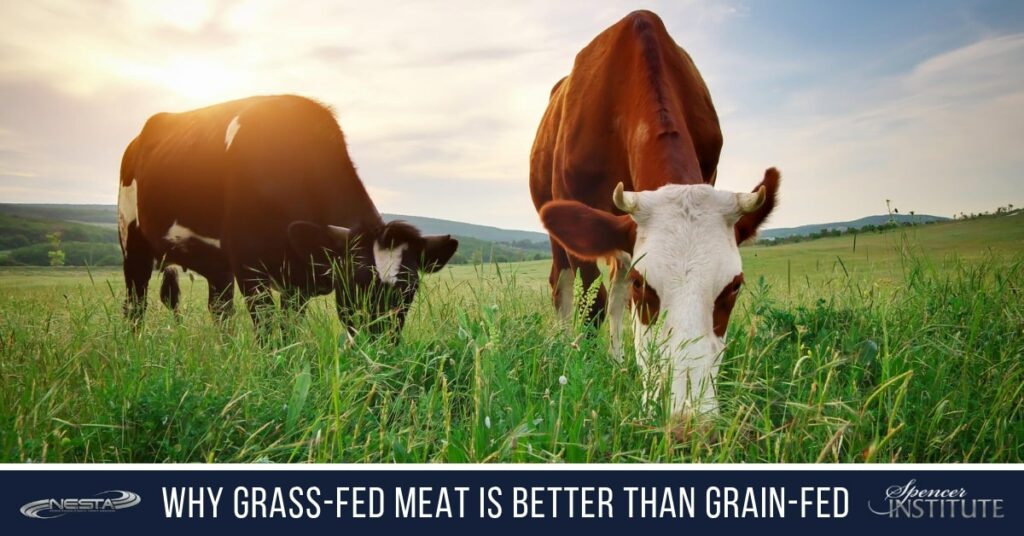 When it comes to beef, many nutritionists believe that grass-fed beef is better for you than grain-fed beef in many ways. In much the same way that what YOU eat affects your health, what livestock are fed affects the flavor and quality of the resulting meat.
When it comes to beef, many nutritionists believe that grass-fed beef is better for you than grain-fed beef in many ways. In much the same way that what YOU eat affects your health, what livestock are fed affects the flavor and quality of the resulting meat.
Using cattle as an example, cattle are fattened with grain before slaughter, yet grain is not a natural part of any cow’s diet. Grain-fed beef is much higher in saturated fat than grass-fed beef, as much as 40% fat content. Saturated fat content affects your heart, weight, and metabolism.
Grain-fed animals are fed corn or soy and occasionally fillers made from cottonseed or animal byproducts. Both grains are often genetically modified and grain-fed cows often suffer a variety of digestive issues and bacterial contamination that require administration of antibiotics that can be passed to the end consumer.
Feedlots and farming methods used to raise grain fattened cattle are often not sanitary. Disease is more easily spread and the temptation to “extend” feed with unhealthy fillers is cost-effective for the farmer. The most recent historical outbreak of Mad Cow Disease was directly linked to farmers and feedlot owners mixing diseased animal parts into feed for cattle.
Grass-Fed Beef Benefits
Grass-fed beef is free of steroids, antibiotics, and hormones. Grass-fed cattle are often raised in a free-range environment and develop a stronger immune system than grain-fed cattle raised in cramped pens. Grass-fed cattle are not force-fed grains that are not natural to them and as a result, do not need antibiotics or steroids.
Grass-fed beef is rich in beta carotene and has nearly 5 times the Vitamins A and E content than grain-fed beef. Grass-fed beef contains Omega 3 fatty acids that are high in Conjugated Linoleic Acid (CLA) which promotes a healthy body weight. Omega-3’s are also helpful for improving your brain chemistry and reducing carbohydrate cravings.
Grass-fed beef has an almost ideal ratio of fat to lean content that healthy people prefer. Grass-fed beef has a saturated fat content often less than 10%, very similar to the fat content of a skinless chicken breast. This low saturated fat content is nearly 50% lower than that of grain-fed beef.
When possible, choose 100% Grass-Fed Organic beef which is produced under the strict standards of the USDA’s National Organic Program. Organic beef is raised following rules for humane handling and living conditions and pasture standards. Most importantly, the use of GMO feed is prohibited. Many consumers are now choosing grass-fed beef for it’s lower fat content, fewer calories and added health benefits.
What’s Next?
If you want to help clients with food, diet, weight management and improving the results of their fitness routines, the Fitness Nutrition Coach course is for you. You will learn about optimal nutrition, including proven techniques for increasing energy, optimal health and decreased dependence on medications. Instantly increase your job and career opportunities with this popular professional credential.
You can become a Certified Personal Fitness Chef and expand your current personal chef business, or add a new profit center for your fitness or wellness business. Many personal chefs cook and coach people in groups to help more people and earn more money per hour. Some chefs provide weekly meal prep service for health-minded customers and athletes.
Check out what it takes to start a career in personal fitness training. This is your most affordable and fastest way to become a highly qualified personal trainer.
NESTA coaching programs are open to anyone with a desire to learn and help others. There are no prerequisites.
That’s it for now.
Take action!
PS: Click here to see many helpful business/career resources







